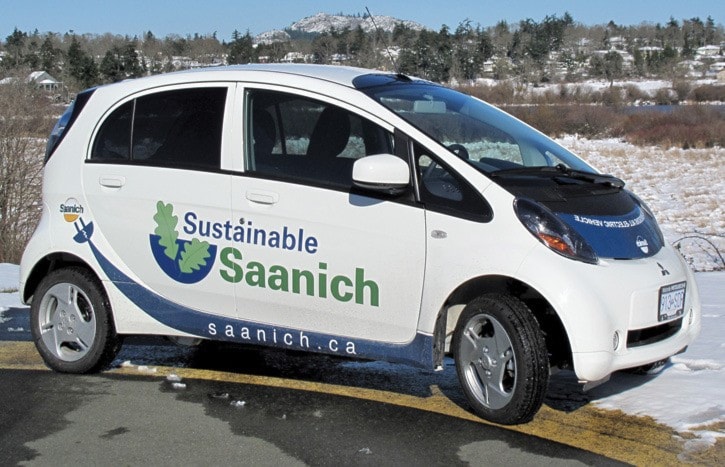A new vehicle in Saanich’s fleet is getting attention at municipal hall, but it’s not the roar of the engine or 1000-watt sound system that has heads turning. In fact, you might not hear the ultra-quiet electric car at all.
In an effort to help cut the region’s carbon footprint in half by 2020, Saanich signed up to participate in a pilot project with Mitsubishi Motor Sales of Canada, developers of the 100 per cent electric, no-emission i-MiEV (Innovative Electric Vehicle).
Saanich’s inspection department received one of the vehicles last week and will supply Mitsubishi with feedback over the course of a three-year lease.
“It has the top speeds of a gas vehicle, with very nice handling as well. It’s a very nice car to drive,” said Mark Boysen, Saanich sustainability co-ordinator. “It’s very comfortable ... (and has a) Very quick pick up and acceleration. People worry that it won’t have the acceleration that they need but it’s there.”
Saanich fuel-powered cars, trucks and SUVs emit over 220,000 tonnes of emissions each year, or 54 per cent of Saanich’s total emissions. The i-MiEV can run 120 kilometres on a single charge and recharge in six hours at Saanich’s 240-volt charging station.
The sole electric vehicle parked at municipal hall fits into Saanich’s in-progress Electric Vehicles Strategy. Managing vehicle use, upgrading gas vehicles and incorporating hybrid vehicles into the municipal fleet are all options being considered as the plan is developed, Boysen said.
“We want to try to reduce those emissions in many ways and the electric car’s not just the one way we’re going to do it.”
As Boysen looks to the future use of more vehicles, he identifies the need for ample charging stations as one potential challenge. Use of heat and air conditioning or aggressive driving will all result in reducing the mileage between charges, just as such behaviours affect gas mileage. Unlike a standard vehicle, the i-MiEV uses kinetic energy from braking to extend the battery charge.
Overall, Boysen sees few drawbacks and predicts electric vehicles are well-suited for the department’s – and residents’ – future needs.
“For most people, the electric car is about changing commuter habits. Most people are going to work inside the CRD. Having an electric car is going to be really helpful for them, having a low-emissions vehicle to get to work and back, not fueling up during the week and charging at homes in the evening.”
The i-MiEV costs about one-tenth of a gas vehicle to run, based on the current cost of hydroelectric power. The car is slated to hit the market later this year. Saanich is in talks to launch a similar project with Nissan by the fall.
“We’ve got 250 different vehicles in our fleet, including trucks,” Boysen added. “There’s no limit to what we could use.”
nnorth@saanichnews.com
